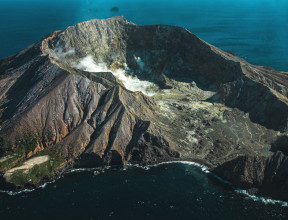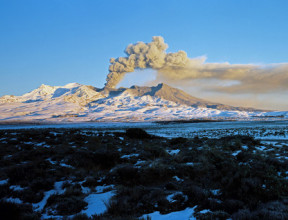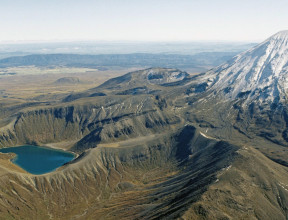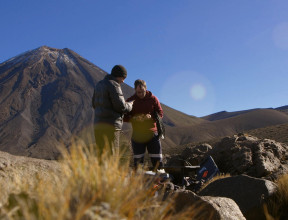
Ash
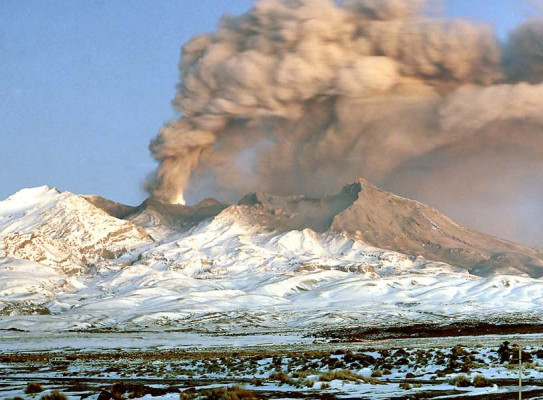
Volcanic ash is the most widespread hazard of explosive volcanic eruptions and the most likely to affect towns, cities and farmland in the North Island of New Zealand.
Ash fall can cause considerable disruption, and can continue long after the volcanic eruption is over.
Pyroclastic fall
When a volcano erupts, it will eject a wide variety of material into the air above it, called pyroclastic fall. Large fragments of material ranging from 0.1 to 10 metres in diameter, rarely land more than 1-2 km from the vent.
Volcanic glass, rock and crystal particles, can also be produced by explosive force into millimetre-sized ash. These fine particles can be carried by currents in the eruption column to high above the volcano and pass into the downwind plume to rain out forming ash fall deposits.
Ash fall impact zones
The impacts of ash fall on people, structures and equipment depends largely on ash thickness. Ash particles commonly have sharp broken edges, which makes them a very abrasive material. In order to simplify hazard assessment and to allow the definition of risk within certain areas, five impact zones can be used. These are areas receiving less than 1mm of ash, those receiving 1-5mm, 5-100mm, 100-300mm and over 300mm. The thicknesses given are for uncompacted ash.

Impacts of Ash Fall
-
Less than 1 mm ash thickness
- Will act as an irritant to lungs and eyes.
- Airports will close due to the potential damage to aircraft.
- Possible minor damage to vehicles, houses and equipment caused by fine abrasive ash.
- Possible contamination of water supplies, particularly roof-fed tank supplies.
- Dust (or mud) affects road visibility and traction for an extended period.
-
1-5 mm ash thickness
Effects that occur with < 1 mm of ash will be amplified, plus:
- Possible crop damage.
- Some livestock may be affected. Most will not be unduly stressed but may suffer from lack of feed, wear on teeth, and possible contamination of water supplies.
- Minor damage to houses will occur if fine ash enters buildings, soiling interiors, blocking air-conditioning filters, etc.
- Electricity may be cut; ash shorting occurs at substations if the ash is wet and therefore conductive. Low voltage systems more vulnerable than high.
- Water supplies may be cut or limited due to failure of electricity to pumps.
- Contamination of water supplies by chemical leachates may occur.
- High water-usage will result from ash clean-up operations
- Roads may need to be cleared to reduce the dust nuisance and prevent storm-water systems from becoming blocked.
- Sewage systems may be blocked by ash, or disrupted by loss of electrical supplies.
- Damage to electrical equipment and machinery may occur.
-
5-100 mm ash thickness
Effects that occur with < 5 mm of ash will be amplified, plus:
- Burial of pasture and low plants. Foliage may be stripped off some trees but most trees will survive.
- Most pastures will be killed by over 50 mm of ash.
- Major ash removal operations in urban areas.
- Most buildings will support the ash load but weaker roof structures may collapse at 100 mm ash thickness, particularly if the ash is wet.
- Road transport may be halted due to the build up of ash on roads. Cars still working may soon stop due to clogging of air-filters.
- Rail transport may be forced to stop due to signal failure bought on by short circuiting if ash becomes wet.
-
100-300 mm ash thickness
Effects that occur with < 100 mm of ash will be amplified, plus:
- Buildings that are not cleared of ash will run the risk of roof collapse, especially large flat roofed structures and if ash becomes wet.
- Severe damage to trees, stripping of foliage and breaking of branches.
- Loss of electrical reticulation due to falling tree branches and shorting of power lines.
-
More than 300 mm ash thickness
Effects that occur with < 300 mm will be amplified, plus:
- Heavy kill of vegetation.
- Complete burial of soil horizon.
- Livestock and other animals killed or heavily distressed.
- Kill of aquatic life in lakes and rivers.
- Major collapse of roofs due to ash loading.
- Loading and possible breakage of power and telephone lines.
- Roads unusable until cleared.
Below are a series of posters, commissioned by the Auckland Lifelines Group (ALG), providing concise best practice information for critical infrastructure managers to effectively prepare for, respond to, and recover from ash-producing volcanic eruptions. Content is based on the latest international research and informed by observations from around the world. We are proud that New Zealand is at the forefront of volcanic ash impacts research, focusing in particular on impacts on critical infrastructure such as water and electricity supplies and transport networks, and thank the ALG for making these posters available.
-
Ash impact posters
- Wastewater Managers (PDF, 1.8 MB)
- Water Supply Managers (PDF, 1.5 MB)
- Roading Managers (PDF, 1.9 MB)
- Airport operators (PDF, 243 KB)
- Power Transmission and Distribution System Operators (PDF, 210 KB)
- Power Plant Operators (PDF, 187 KB)
- Facilities Managers: Buildings (PDF, 1.4 MB)
- Facilities Managers: Gensets and HVAC (PDF, 449 KB)
- Facilities Managers: Computers and Electronics (PDF, 261 KB)
- Urban Clean-up Operations (PDF, 1.6 MB)
- Telecommunications System Operators (PDF, 1.4 MB)
Volcanic ash sampling
We really appreciate your help in collecting volcanic ash samples. These samples help us understand the properties of the ash, which is vitally important for a range of purposes from studying eruption style to
forecasting eruptions and assessing ashfall hazards.
